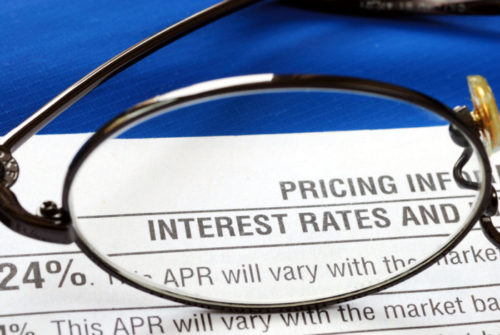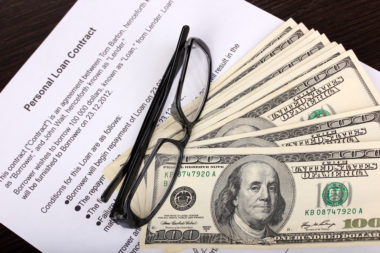A wide variety of interest rates are available for personal loans, depending on factors like the borrower’s credit score, the amount they’re borrowing, and the state of the economy.
The Chamber of Commerce notes that average interest rates for personal loans vary from 10% to 28%. In 2020, the average interest rate for a 24-month personal loan was 9.34%, according to the Federal Reserve. The interest rate for a personal loan will often depend on a few qualifying factors: the current economy, your credit score, your geographic location, and the lender you choose to borrow from.
Table of Contents
Average Personal Loan Interest Rate by Year
A statistical release from the Federal Reserve shows how average interest rates for 24-month personal loans change per annum. Interest rates change over time and are influenced by the status of the economy. Average interest rates for personal loans in 2020 are lower than in previous years:
- 2015: 9.75%.
- 2016: 9.69%.
- 2017: 10.13%.
- 2018: 10.32%.
- 2019: 10.21%.
- 2020: 9.34%.
Average Personal Loan Rate by Credit Score
When applying for a personal loan, your credit score will impact the interest rate the lender will offer you. You do not need perfect credit to apply for a loan but in general, the higher your credit score is, the lower your interest rate will be. You can still apply for personal loans with average or poor credit, but the interest rate may be much higher.
According to Business Insider, the average interest rate on high-end personal loans for each credit score range is:
- 12.5% for consumers with excellent credit (720 or higher).
- 15.5% for consumers with good credit (between 690 and 719).
- 19.9% for consumers with fair credit (630 to 689).
- 32% for consumers with bad credit (629 or lower).
Personal Loan Interest Rates by Lender
There are a few lending options for personal loans. You may choose to get a personal loan from a bank, a credit union, or an online lender that may offer quick same-day loans.
The National Credit Union Association notes that, as of September 25, 2020, the national average interest rates for an unsecured 3-year personal loan were 10.13% from banks and 9.15% from credit unions. The following sections will provide examples of annual percentage rates (APRs) for personal loans from each lending type.
Banks
- Citibank: 7.99% to 23.99%.
- Discover: 6.99% to 24.99%.
- U.S. Bank: 6.49% to 19.99%.
- Wells Fargo: 5.74% to 20.24%.
Credit Unions
- USAA: 7.24% to 17.75%.
- Navy Federal Credit Union: 7.49% to 18%.
- Members 1st Federal Credit Union: 7.49% to 10.49%.
Online Lenders
- Avant: 9.95% to 35.99%.
- Best Egg: 5.99% to 29.99%.
- Lending Club: 10.68% to 35.89%.
- OneMain Financial: 18% to 35.99%.
What Is Considered a Good Interest Rate on a Personal Loan?
In general, a good interest rate is one that is lower than the annual national average. However, there are multiple factors that will play into the interest rate you’ll receive from a lender. If you have excellent credit, you would expect a good interest rate to be 10.3% or under. If you have poor credit, you would expect a good interest rate to be 28.5% or under.
Factors That Affect Your Personal Loan Interest Rate
If you are planning to apply for a loan, there are a few factors that will affect your interest rate.
Geographic Location and Usury Laws
Each state is subject to usury laws that are mandated and regulated at the state level. These usury laws dictate state-specific regulations for interest rates, maximum rate caps, and exceptions to rate limits to ensure protection for the borrower against predatory or abusive lending.
Credit History and Credit Score
Your credit score and history will play a large role in the interest rate of your loan. When a lender reviews your credit history, they often look at:
- The length of your credit history — Typically the last one to two years.
- Any negative marks in your credit history — How often or how recently they occurred.
- The number of credit inquiries you’ve had in the past year.
A benefit of having excellent or good credit often includes low interest rates and a higher chance of approval for the loan. There are loans available to those with bad credit loans available to those with bad credit, or those with no income, but the interest rate may be higher than average.
Employment Status and Debt-to-Income Ratio
Many lenders will want to analyze your financial health before approving a loan. A lender may ask about your employment status, your household income, and your debt-to-income ratio.
Lenders use these factors to determine if you will be able to pay the loan back or not, and your debt-to-income ratio may affect the annual percentage rate you are offered. If you have poor credit and need an emergency loan, you may consider a no-credit-check installment loan.
Installment loans tend to have high interest rates that are well above average; they should be considered as a last resort option if you do not have an emergency fund and you are in a financial crisis.
The Term and Amount of the Loan
Loans with longer terms and higher amounts will typically have higher interest rates; this is because lenders are taking on the risk that the loan may not be paid back, and accepting that it may take time for the funds to be repaid.
A long-term loan typically offers lower monthly payments, so long-term loans may be a good option for those with poor credit. However, a long-term loan will also mean that your loan balance stays higher for longer, meaning you could be paying more interest in the long run, even if you have an average or below-average APR.
Image Source: https://depositphotos.com/





